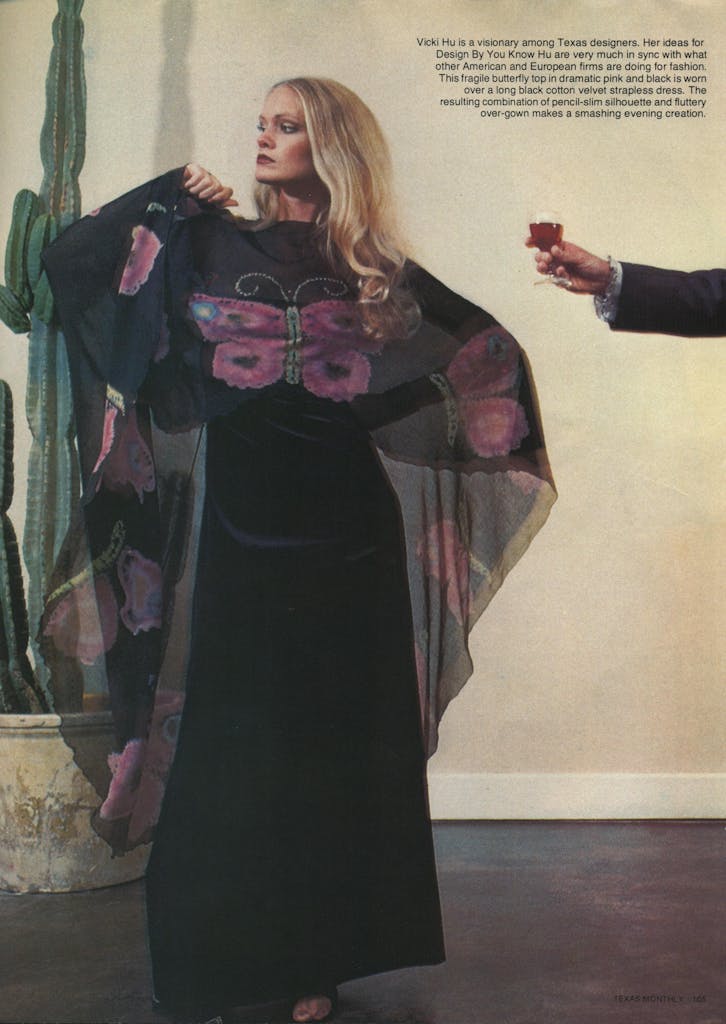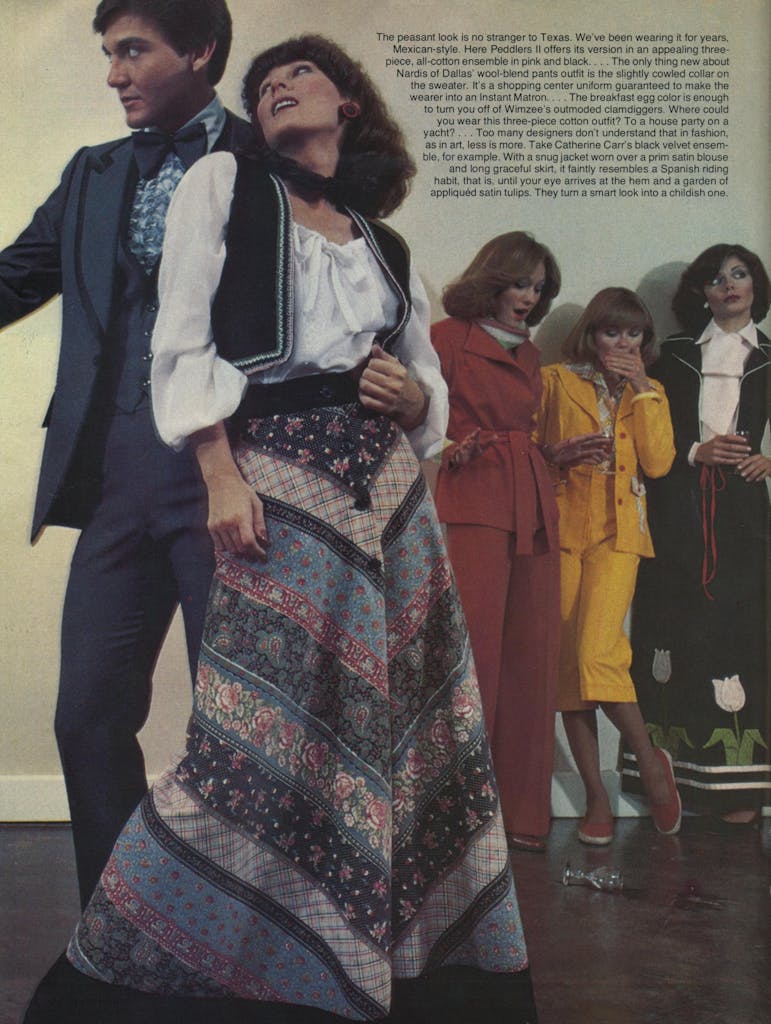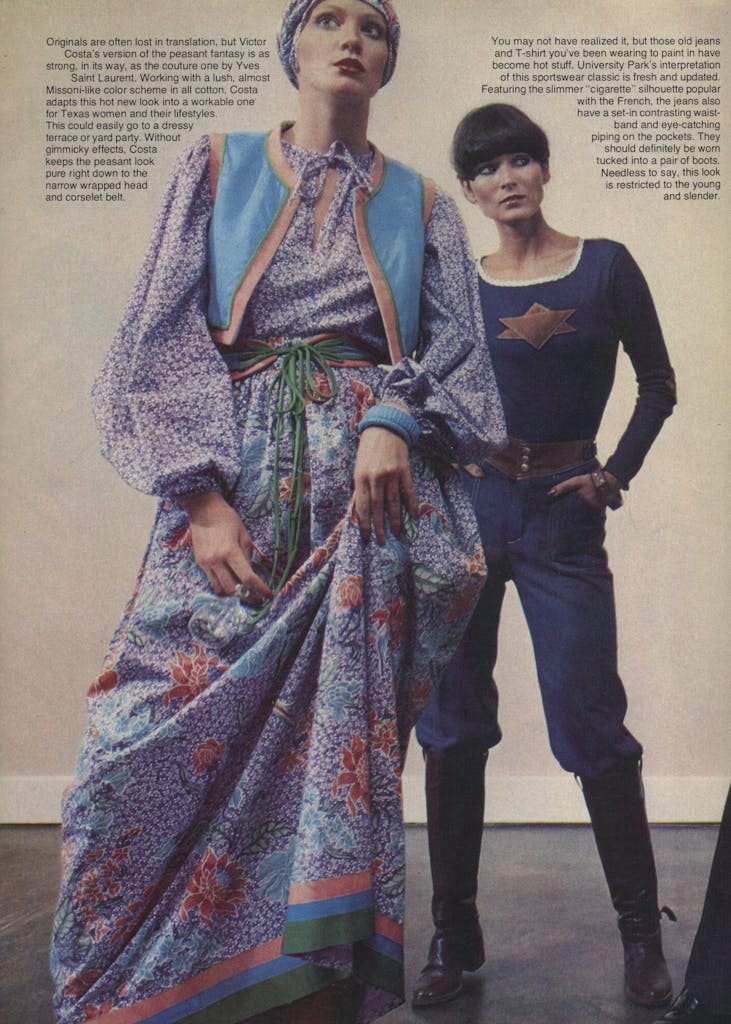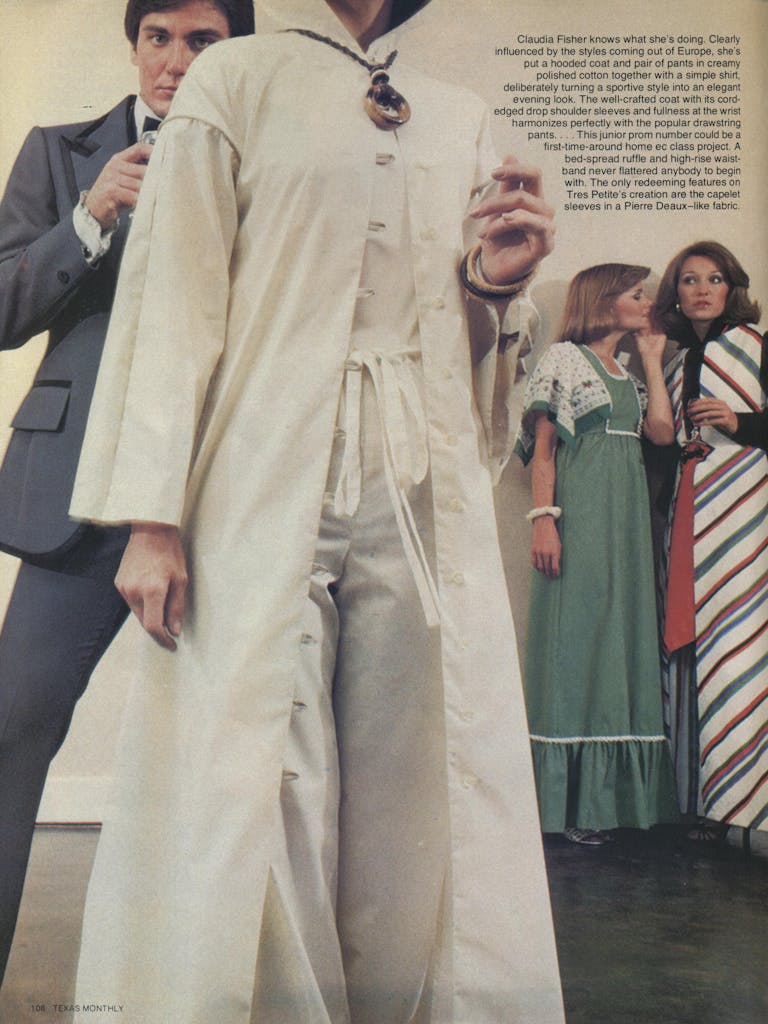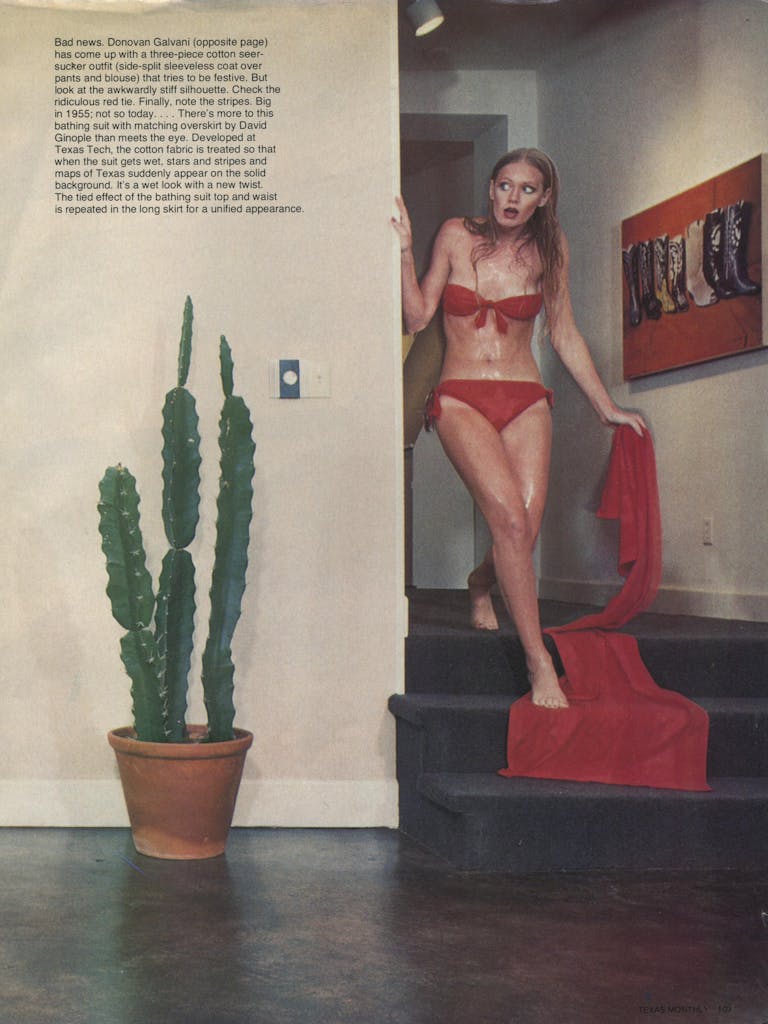It’s not easy to shake the stereotyped notion that all Texans dress as if they lived on the King Ranch. Whether we like it or not, the rest of the world sees Texas as synonymous with Western wear, and, barring a revolution in mass thinking, the label seems likely to stick. Of course, we don’t want to totally dispel that idea. After all, cowboy chic has suddenly gotten very uptown, and, with Cher and Candice Bergen buying Noconas in Beverly Hills boutiques and vintage pearl-snap Western shirts going for Eiffel Tower-high prices in Paris, the Larry Mahan label will soon be as sought after as Calvin Klein. At least Texans were onto the look before anyone else, and, as fashion aficionados know, being first is part of being fashionable.
But aside from Western wear, Texas clothes really haven’t come out of the closet. Elsewhere in the world Texans are thought to be flamboyant and colorful, but the clothes we manufacture for ourselves say another thing about us—that we are unimaginative, naive, lackluster, and unsure. Texas’ distinctive image doesn’t extend to fashion, and thus the Lone Star State is running behind New York and Los Angeles when it comes to clothes. This is all the more disturbing since Texas has both the facilities and the natural resources to move readily into the upper echelons of the fashion business. Although the big Texas labels—people like Victor Costa, Howard Wolf, Clifton Wilhite, and Les Wilk—are making a few appearances in national magazines, they are still mainly hometown affairs. Boasting almost 8000 apparel and accessory firms with an annual total sales volume of $1.5 billion, Texas has more than just potential. Dallas, with 34 apparel plants within its city limits, is the third-largest apparel manufacturer in the United States and the home of the Dallas Apparel Mart, reportedly the world’s largest wholesale merchandising mart on a single site.
Obviously, the facilities are there and, judging by the “Texas Naturally” fashion show that recently premiered in Dallas (see photos), so is the design savvy. The problem is the timid Texas consumer who, nine times out of ten, prefers to play it safe rather than sorry. Of course, we are in the vast middle of America, and that orientation is a big factor keeping Texas from taking its rightful place as a leader in the international fashion community. There is no excuse for the wife of a Houston/Dallas retailer to admit ruefully that the only things “made in Texas” in her wardrobe are the obligatory jeans and cowboy shirt. In all fairness to Texas designers and consumers, it’s often the manufacturers who stolidly resist veering off the middle-of-the-road course with an untried design. When it comes down to the bottom line, Big Bucks win out over Big Looks.
A catch-22 situation operates to keep originality down in Texas. I recall a conversation I had with the president of a large, Dallas-based sportswear firm while I was covering fashion for Women’s Wear Daily. Commenting on the absence of any fashion news in his company’s latest line of pantsuits, he said, “Honey, we’re only giving the ladies what they want.” To which I asked, “But how do you know what these women really want to wear?” Looking blankly at me, he replied, “Well, they’re buying them, that’s how.”
It is this same give-’em-what-they’ll-buy attitude that keeps Texas a polyester paradise. Clothes made of synthetic fibers sell well in Texas, as they do in the rest of middle America, yet the irony is that Texas is a world leader in the production of natural fibers. We put forth an average of 30 per cent of the cotton grown in the U.S., 19 per cent of the wool, and 97 per cent of the mohair. We produce the lion’s share of the raw polyesters as well, but somehow other folks get our natural fibers. So it’s not a question of whether exciting, newsy clothes can be designed and made in Texas, it’s the nagging doubt that the consumer will buy them that keeps the manufacturer plodding down the middle of the fashion road.
Fashion experimentation languishes in Texas but flourishes in New York partly because New York prompts competitiveness and permits audacity. The New York woman is seldom diffident about getting herself together—a spirit that women in Texas and elsewhere tend to lack. The New York woman has only to see her outfit on two other females and she’ll either burn it or permanently retire it to the back of the closet. In Texas, when a woman sees an outfit on two other women, she marches right out and buys one for herself. It’s true that living at the center of the garment industry—New York gets first deliveries on both American and European clothes—does fire one’s energy to try new things.
Of course, preoccupation with fashion can and does get out of hand, and there’s a lot to be said for the easygoing attitude of the Texas woman who refuses to be dragged into the fashion game. Taken to its extreme, that game is an overindulgent, narcissistic pastime, and it’s to her credit that the Texas woman hasn’t fallen victim to following the fashion of the hour (like last season’s four-inch platforms), no matter how expensive, how ridiculous, or how uncomfortable. Besides which, Texas stores are not utterly devoid of au courant lines. Neiman’s name has entered the national consciousness, and Saks Fifth Avenue and Frost Brothers carry well-established New York and European labels. Sakowitz just became the first retail store in the U.S. to open a branch of the kicky Milan boutique Fiorucci, and Tootsie’s, another Houston shop, has been racking Kenzo, Ann Buck, and other hot designers for several seasons now. Dallas has, besides N-M, Lou Lattimore, Marie Leavell, and Christopher’s; Houston also has Isabell Gerhart and Esther Wolf; and even in Austin, Maya has been raising the Capital City’s fashion consciousness for several years. These stores carry big-name lines because clothes with fancy labels and/or extreme styling give them nationwide prestige and the impression of fashion awareness. Even though they may end up taking huge markdowns on the clothes, executives love to see their store names listed in the shopping information in Vogue and Bazaar each month.
On the whole, though, fashion in Texas cannot be called wildly experimental. But that doesn’t mean it has to stay that way. There are indications that as Texas grows more urban, its new cosmopolitan awareness will force a rethinking of fashion by manufacturer and consumer. “Texas Naturally” is one of the most hopeful signs that Texas fashion is coming of age. Sponsored by the Dallas Fashion Group in conjunction with the Texas Food and Fiber Commission, the show set out to predict what Texas fashion can become if and when it matures. Designers across the state from established apparel firms and small custom operations were commissioned to create individualized looks in natural fibers (the closest some of them could come were natural/synthetic blends, and a few had to bow out completely because they worked only with synthetics). The result was a 78-piece show full of pleasant surprises—as well as a few clinkers.
Never has the peasant dress looked more sensible than in Victor Costa’s version of the fantasy fashion Yves Saint Laurent is credited with starting. Vickie Hu’s chiffon tops over strapless evening dresses went beautifully with Zandra Rhodes’ and Holly Harp’s elegantly fanciful and high-toned designs. David Ginople’s clever swimwear outfit made a huge splash with the audience, and Claudia Fisher’s sophisticated use of layers elevated her sportive separates—hooded coat over pants—to a high level of design. “The ability is here, no question about it, but it’s often not permitted or encouraged. Texas fashion is struggling, but we’re hanging in there, trying to climb up the fashion ladder,” said Kim Dawson, fashion director of the Dallas Apparel Mart, who, with her equally energetic assistant, Barbara Klindworth, produced the show.
For all its good intentions, “Texas Naturally” has one major drawback: these clothes may never actually be cut, put into existing lines, or sold to retail stores. Most were created exclusively for the show, and unless manufacturers pick up the designers’ lead, the items that prophesied a bright future for Texas fashion will probably never find their way onto the back of a Texas customer. On the other hand, “Texas Naturally” wasn’t just a one-night stand: it will go to Kansas City, Atlanta, Mexico City, Tokyo, Paris, and Sydney, Australia.
The final point to be made about the show—and about Texas fashion in general—is that we still do not have an original and sophisticated Texas look. The best pieces on the runway were spin-offs of name lines of Paris, New York, and California. Obviously Texas designers have been watching what’s going on, but they have yet to strike out on their own. If it’s any consolation, only in the last few years has American (meaning New York) fashion acquired international (meaning Paris) acceptance. And if New York has felt Paris’ slight, imagine how California’s designers have felt all this time in the shadow of the Big Apple. Texas has the apparel facilities and natural fibers industries, not to mention more and more fashionable Texans, to remind us that the Roy Rogers-Dale Evans stereotype may be getting threadbare. The East and West coasts are finally making it in the world of fashion. Texas, if it dares, will not be far behind.
Vicki Hu is a visionary among Texas designers. Her ideas for Design By You Know Hu are very much in sync with what other American and European firms are doing for fashion. This fragile butterfly top in dramatic pink and black is worn over a long black cotton velvet strapless dress. The resulting combination of pencil-slim silhouette and fiuttery over-gown makes a smashing evening creation.
The peasant look is no stranger to Texas. We’ve been wearing it for years, Mexican-style. Here Peddlers II offers its version in an appealing three-piece, all-cotton ensemble in pink and black. . . . The only thing new about Nardis of Dallas’ wool-blend pants outfit is the slightly cowled collar on the sweater. It’s a shopping center uniform guaranteed to make the wearer into an Instant Matron. . . . The breakfast egg color is enough to turn you off of Wimzee’s outmoded clamdiggers. Where could you wear this three-piece cotton outfit? To a house party on a yacht? . . . Too many designers don’t understand that in fashion, as in art, less is more. Take Catherine Carr’s black velvet ensemble, for example. With a snug jacket worn over a prim satin blouse and long graceful skirt, it faintly resembles a Spanish riding habit, that is, until your eye arrives at the hem and a garden of appliqued satin tulips. They turn a smart look into a childish one.
Originals are often lost in translation, but Victor Costa’s version of the peasant fantasy is as strong, in its way, as the couture one by Yves Saint Laurent. Working with a lush, almost Missoni-like color scheme in all cotton, Costa adapts this hot new look into a workable one for Texas women and their lifestyles.This could easily go to a dressy terrace or yard party. Without gimmicky effects, Costa keeps the peasant look pure right down to the narrow wrapped head and corselet belt. . . . You may not have realized it, but those old jeans and T-shirt you’ve been wearing to paint in have become hot stuff. University Park’s interpretation of this sportswear classic is fresh and updated. Featuring the slimmer “cigarette” silhouette popular with the French, the jeans also have a set-in contrasting waistband and eye-catching piping on the pockets. They should definitely be worn tucked into a pair of boots. Needless to say, this look is restricted to the young and slender.
Claudia Fisher knows what she’s doing. Clearly influenced by the styles coming out of Europe, she’s put a hooded coat and pair of pants In creamy polished cotton together with a simple shirt, deliberately turning a sportive style into an elegant evening look. The well-crafted coat with its cord-edged drop shoulder sleeves and fullness at the wrist harmonizes perfectly with the popular drawstring pants. . . . This junior prom number could be a first-time-around home ec class project. A bed-spread ruffle and high-rise waistband never flattered anybody to begin with. The only redeeming features on Tres Petite’s creation are the capelet sleeves in a Pierre Deaux-like fabric. . . . Bad news. Donovan Gaivani has come up with a three-piece cotton seersucker outfit (side-split sleeveless coat over pants and blouse) that tries to be festive. But look at the awkwardly stiff silhouette. Check the ridiculous red tie. Finally, note the stripes. Big in 1955; not so today.
There’s more to this bathing suit with matching overskirt by David Ginopie than meets the eye. Developed at Texas Tech, the cotton fabric is treated so that when the suit gets wet, stars and stripes and maps of Texas suddenly appear on the solid background. It’s a wet look with a new twist. The tied effect of the bathing suit top and waist is repeated in the long skirt for a unified appearance.
- More About:
- Style & Design
- Western Wear
- Fashion

